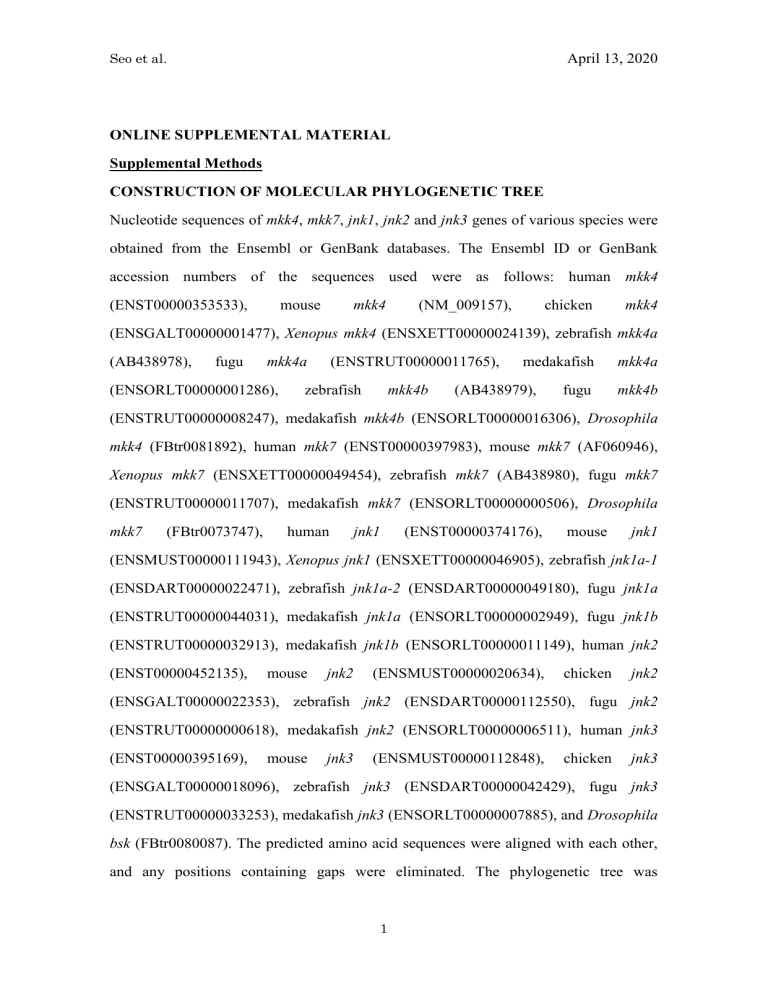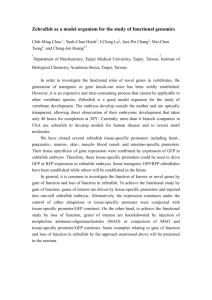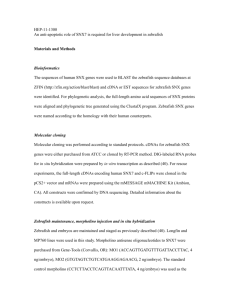JCB_22616_sm_SupplMat

Seo et al. April 13, 2020
ONLINE SUPPLEMENTAL MATERIAL
Supplemental Methods
CONSTRUCTION OF MOLECULAR PHYLOGENETIC TREE
Nucleotide sequences of mkk4 , mkk7 , jnk1 , jnk2 and jnk3 genes of various species were obtained from the Ensembl or GenBank databases. The Ensembl ID or GenBank accession numbers of the sequences used were as follows: human mkk4
(ENST00000353533), mouse mkk4 (NM_009157), chicken mkk4
(ENSGALT00000001477), Xenopus mkk4 (ENSXETT00000024139), zebrafish mkk4a
(AB438978), fugu mkk4a (ENSTRUT00000011765), medakafish mkk4a
(ENSORLT00000001286), zebrafish mkk4b (AB438979), fugu mkk4b
(ENSTRUT00000008247), medakafish mkk4b (ENSORLT00000016306), Drosophila mkk4 (FBtr0081892), human mkk7 (ENST00000397983), mouse mkk7 (AF060946),
Xenopus mkk7 (ENSXETT00000049454), zebrafish mkk7 (AB438980), fugu mkk7
(ENSTRUT00000011707), medakafish mkk7 (ENSORLT00000000506), Drosophila mkk7 (FBtr0073747), human jnk1 (ENST00000374176), mouse jnk1
(ENSMUST00000111943), Xenopus jnk1 (ENSXETT00000046905), zebrafish jnk1a-1
(ENSDART00000022471), zebrafish jnk1a-2 (ENSDART00000049180), fugu jnk1a
(ENSTRUT00000044031), medakafish jnk1a (ENSORLT00000002949), fugu jnk1b
(ENSTRUT00000032913), medakafish jnk1b (ENSORLT00000011149), human jnk2
(ENST00000452135), mouse jnk2 (ENSMUST00000020634), chicken jnk2
(ENSGALT00000022353), zebrafish jnk2 (ENSDART00000112550), fugu jnk2
(ENSTRUT00000000618), medakafish jnk2 (ENSORLT00000006511), human jnk3
(ENST00000395169), mouse jnk3 (ENSMUST00000112848), chicken jnk3
(ENSGALT00000018096), zebrafish jnk3 (ENSDART00000042429), fugu jnk3
(ENSTRUT00000033253), medakafish jnk3 (ENSORLT00000007885), and Drosophila bsk (FBtr0080087). The predicted amino acid sequences were aligned with each other, and any positions containing gaps were eliminated. The phylogenetic tree was
1
Seo et al. April 13, 2020 constructed using the neighbor-joining method and ClustalX software. The reliability of the tree was estimated using the bootstrap method and 10,000 replications.
RESCUE EXPERIMENT
For Mkk4b overexpression, a construct encoding full-length zebrafish Mkk4b mRNA was created by cloning the relevant fragment (amplified by high-fidelity PCR) into the pCS2+ plasmid.
Supplemental Figure Legends
Fig. S1. Molecular cloning of zebrafish mkk4a , mkk4b and mkk7 genes and their evolutionary relationships in various model organisms. A: Alignment of amino acid (aa) sequences of zebrafish Mkk4a-s, Mkk4a-l, Mkk4b (top) and Mkk7 (bottom) with their mouse homologs.
Amino acids were aligned using the ClustalX program.
Black background, identical aa; shaded background, similar aa. Dashes, gaps introduced to optimize alignment. Asterisks, potential phosphorylation sites in the activation domain.
B: Molecular phylogenetic trees of Mkk4 and Mkk7 constructed on the basis of aa identity. The deepest roots of the trees were determined by using the sequences of the
Drosophila Mkk4 and Mkk7 homologs as outgroups. The estimated bootstrap probabilities (percent) of local topologies are shown on each node. The length of the scale bar corresponds to an evolutionary distance of 0.02 aa substitution per site (2% sequence difference).
Fig. S2. Defects caused by mkk4b MO injection can be rescued by mkk4b mRNA injection.
Fertilized zebrafish eggs were injected with mkk4b MO alone or mkk4b MO plus mkk4b mRNA. Top: The gross appearance of embryos was examined at 24 hpf.
Embryos were scored morphologically for three categories of CE movement defects: rescued (white box), moderate (grey box) and severe (black box). Bottom:
2
Seo et al. April 13, 2020
Quantification of the percentage of embryos in each category in top panel. Co-injection of mkk4b mRNA increased the percentage of rescued embryos.
Fig. S3. Epiboly is delayed in mkk4b morphants.
Embryos were treated at 1 cell stage with control or mkk4b MOs and the progression of morphogenetic movements during epiboly were captured in live images at 7, 8, 9 and 10 hpf. Mkk4b morphants are indistinguishable from controls through the shield stage. However, although a low amount of mkk4b MO (0.2 pmol) did not interfere with epiboly progression (center column), a higher concentration of mkk4b MO (0.4 pmol) led to a defect in epiboly from
9 hpf to 10 hpf (right column). Arrowheads mark the position of the blastoderm margin during gastrulation.
Fig. S4. Phenotypic analyses of mkk4a morphants. A: Validation of mkk4a MO efficacy as for Fig. 2A. Top: The mkk4a MO targets the exon 5/intron 5 junction of mkk4a pre-mRNA as shown in the diagram. Arrows represent primer pairs used in RT-PCR analysis. Bottom: The mkk4a MO (0.8 pmol) efficiently prevents correct splicing of mkk4a pre-mRNA beginning at the shield stage (6 hpf). B: Gross appearance of mkk4a
MO-injected embryos. Images of a live untreated WT embryo and live mkk4a morphants injected with the indicated doses of mkk4a MO are viewed laterally, with anterior to the top. No defects are obvious at 24 hpf. Scale bar = 1 mm. C: Normal CE in mkk4a morphants. WT embryos and mkk4a MO-injected embryos were analyzed by whole-mount in situ hybridization for the expression of tissue-specific genes at the tailbud stage (10 hpf). Comparable expression patterns of hgg1 (prechordal plate), dlx3
(edge of the neural plate), ntl (notochord), pax2.1 (midbrain/hindbrain boundary) were observed.
Fig. S5. Translation-blocking and splice-blocking mkk MOs produce embryos that are
3
Seo et al. April 13, 2020 phenotypically similar.
A: Gross appearance of embryos injected with 2.4 pmol of control MO or translation-blocking MOs mkk4a-l atgMO, mkk4b atgMO or mkk7 atgMO. Images of live morphants are viewed laterally, with anterior to the top.
Treatment with mkk4a-l atgMO induced no defects, whereas treatment with mkk4b atgMO or mkk7 atgMO caused a reduction in body axis extension at 23 hpf. Scale bar =
200 µm. B: Control morphants and translation-blocking morphants were analyzed for tissue-specific gene expression as for Fig. 2D. The expression patterns of all tissue-specific genes examined were normal in embryos injected with mkk4a-l atgMO or mkk7 atgMO. In mkk4b atgMO-injected embryos, the prechordal plate ( hgg1 ) is located more posteriorly, the neural plate ( dlx3 ) is wider, the notochord ( ntl ) is shorter and broader, and the midbrain/hindbrain boundary ( pax2.1
) has expanded laterally, similar to the changes observed in mkk4b MO morphants.
Fig. S6. Phylogenetic classification of zebrafish Jnks.
Four zebrafish jnk genes were classified as members of the indicated vertebrate jnk families on the basis of aa sequence. The deepest roots of the trees were determined using the sequence of the
Drosophila Jnk homolog (Basket) as an outgroup. The estimated bootstrap probabilities
(percent) of local topologies are shown on each node. The length of the scale bar corresponds to an evolutionary distance of 0.02 aa substitution per site (2% sequence difference).
Fig. S7. Schematic proposed model for the function of Mkk4b-Jnk signaling during vertebrate CE.
Top: During the gastrulation of a normal WT zebrafish embryo, Wnt11 engages the Frizzled receptor and activates the Mkk4b-Jnk signaling cascade. As a result, activated Jnk induces an as-yet-unidentified signaling molecule (X) that is able to non-cell-autonomously suppress wnt11 transcription in the neighboring organizer and margin regions of the embryo, allowing the initiation of CE. Bottom: MO-mediated
4
Seo et al. April 13, 2020 knockdown of mkk4b reduces Jnk activation, abrogating Jnk-induced X production and suppression of wnt11 transcription. As a result, wnt11 is constitutively expressed in the organizer and margin regions, impairing CE.
Fig. S8. Mkk4a-s but not Mkk4a-l is involved in dorsoventral patterning. WT zebrafish embryos were injected with 2.4 pmol of control MO, mkk4a-s atgMO, or mkk4a-l atgMO, and examined for dorsal marker gsc expression at the shield stage by in situ hybridization. Shown are animal pole views, with dorsal toward the right. The knockdown of mkk4a-s, but not mkk4a-l, leads to elevated expression of gsc .
5







